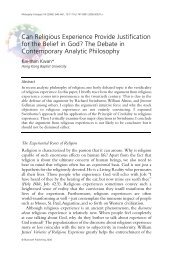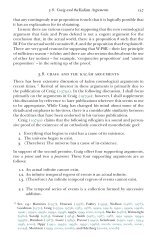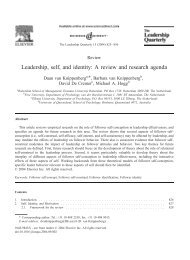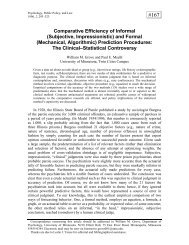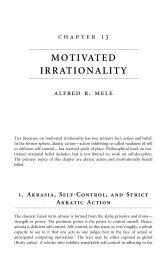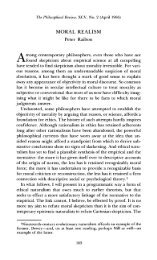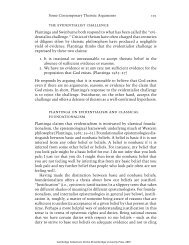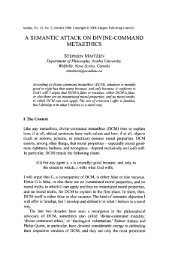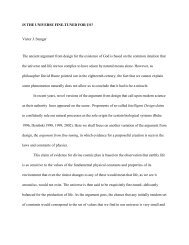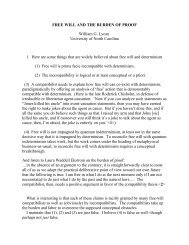The Cambridge Handbook of Expertise and Expert Performance
The Cambridge Handbook of Expertise and Expert Performance
The Cambridge Handbook of Expertise and Expert Performance
Create successful ePaper yourself
Turn your PDF publications into a flip-book with our unique Google optimized e-Paper software.
Research Approaches to Individual<br />
Differences in Music<br />
CHAPTER 26<br />
Music<br />
Andreas C. Lehmann & Hans Gruber<br />
Individual differences in musical achievement<br />
have at all times awed musicians <strong>and</strong><br />
audiences alike. In former times, royalty<br />
<strong>and</strong> nobility invited outst<strong>and</strong>ing musicians<br />
to perform in their salons. Today, the general<br />
public crowds the concert halls when<br />
certain celebrities perform while other concerts<br />
are scarcely attended. Sometimes, special<br />
attractions such as child prodigies or<br />
musical savants capture the attention <strong>of</strong> the<br />
mass media.<br />
Scientific attempts to underst<strong>and</strong> individual<br />
differences have existed for a<br />
long time. Barrington (1770) investigated<br />
Mozart’s early performance achievements<br />
<strong>and</strong> described it in some detail. Such singlecase<br />
studies are highly informative. However,<br />
they usually do not suffice for modern<br />
scientific st<strong>and</strong>ards. <strong>The</strong>y merely document<br />
high achievements under controlled conditions<br />
<strong>and</strong> attribute them to exceptional levels<br />
<strong>of</strong> talent. Doubts can be expressed about<br />
the accuracy <strong>and</strong> reliability <strong>of</strong> the information<br />
presented in biographies <strong>of</strong> famous<br />
musicians. More recent biographies mention<br />
skill acquisition explicitly from the perspective<br />
<strong>of</strong> musical talent research. This research<br />
explains exceptional performance as based<br />
in innate musical capacities.<br />
Billroth’s (1895) “Who is musical?” can be<br />
seen as a starting point for research on musical<br />
abilities in the 19 th century. Later in the<br />
1920s <strong>and</strong> 30s Seashore developed his “Measures<br />
<strong>of</strong> musical talents”, which assessed<br />
subjects’ perceptual discrimination abilities<br />
(Seashore, 1938/1967). With few exceptions,<br />
such as Wellek’s attempt in 1939 to identify<br />
racial differences in musical abilities<br />
(Wellek, 1970), most music aptitude tests<br />
have tried to predict the potential for music<br />
performance (Boyle, 1992, for a review).<br />
<strong>The</strong>ir overall success was limited, however,<br />
probably because the effects <strong>of</strong> talent tend<br />
to be confounded with the amount <strong>of</strong> previous<br />
training, which is rarely statistically controlled<br />
for. Generally, musically active children<br />
tend to score higher in such ability tests<br />
(Shuter-Dyson, 1999).<br />
Another argument in favor <strong>of</strong> innate ability<br />
arises from musical dynasties, for example,<br />
the Bach, Corelli, Couperin, Garcia, <strong>and</strong><br />
457
458 the cambridge h<strong>and</strong>book <strong>of</strong> expertise <strong>and</strong> expert performance<br />
Strauss families, which by their mere existence<br />
suggest a strong heritability <strong>of</strong> musical<br />
talents. Alas, the hope to identify heritability<br />
<strong>of</strong> excellence in families is not justified<br />
(see also discussion about Galton, 1979;e.g.,<br />
Simonton, Chapter 18). Genetic background<br />
<strong>and</strong> environmental effects are mingled<br />
inevitably, <strong>and</strong> alternative explanations cannot<br />
be refuted. Older heritability explanations<br />
failed to take into account the genetic<br />
contribution <strong>of</strong> females in the genealogy<br />
or to the socio-historic fact that sons frequently<br />
followed in their fathers’ pr<strong>of</strong>essions<br />
(Farnsworth, 1969). Hence, there are<br />
different explanations for why many musicians<br />
have parents who are musically active<br />
(Gembris, 1998).<br />
<strong>The</strong> home environment is obviously<br />
important for promoting musical excellence<br />
(Csikszentmihalyi, Rathunde, & Whalen,<br />
1993; Sosniak, 1985). Also, the socioeconomic<br />
conditions <strong>of</strong> a young musician’s<br />
family constitute obvious factors that influence<br />
the choice <strong>of</strong> a teacher, the quality<br />
<strong>of</strong> the instrument played, <strong>and</strong> other possibilities<br />
awarded to the learner. An analysis<br />
<strong>of</strong> successful Polish musicians by Manturzewska<br />
(1995) revealed a common pattern<br />
<strong>of</strong> attitudes, value systems, <strong>and</strong> family<br />
structure in the musicians’ families <strong>of</strong> origin.<br />
Families were emotionally stable, task oriented,<br />
<strong>and</strong> careful in selecting their children’s<br />
friends, <strong>and</strong> they strongly supported<br />
the musical activities. <strong>The</strong>se attitudes gain<br />
importance as they translate into behavioral<br />
consequences in the daily lives <strong>of</strong> musicians.<br />
For example, Csikszentmihalyi, Rathunde,<br />
<strong>and</strong> Whalen (1993) demonstrated that families<br />
<strong>of</strong> high-achieving children changed<br />
their lives to accommodate the needs <strong>of</strong><br />
their talented <strong>of</strong>fsprings, for example, by<br />
exempting them from household chores<br />
to give them additional time to practice.<br />
Biographies <strong>of</strong> famous musicians underline<br />
such practices: the cellist Jacqueline du Pre<br />
never did her own laundry <strong>and</strong> did not have<br />
any household responsibilities as an adolescent<br />
(Easton, 1989).<br />
Taken together, it is difficult to obtain<br />
clear evidence on the role <strong>of</strong> innate abilities,<br />
despite the fact that giftedness features<br />
prominently in everyday discourse. On the<br />
other h<strong>and</strong>, much evidence exists that practice<br />
<strong>and</strong> other environmental factors have<br />
a large impact on changes in many variables<br />
related to music performance. Some<br />
researchers have expressed serious doubts<br />
whether it is even possible to identify specific<br />
innate characteristics that mediate the<br />
development <strong>of</strong> expertise (Ericsson, 2003).<br />
However, the goal <strong>of</strong> this chapter is not<br />
to work out the nature-nurture debate for<br />
music but to focus on the role <strong>of</strong> practice<br />
for the attainment <strong>of</strong> expert performance.<br />
In brief, we do not know whether practice is<br />
a sufficient condition for high achievement,<br />
but it is certainly a necessary one for invoking<br />
the cognitive, physiological, <strong>and</strong> psychomotor<br />
adaptations observed in experts.<br />
Although practice is omnipresent during<br />
the development <strong>of</strong> expertise in music,<br />
its role <strong>and</strong> manifestation is not identical<br />
in all musical genres. Different musical<br />
styles are characteristic for specific musical<br />
cultures, <strong>and</strong> those different cultures<br />
have their respective types <strong>of</strong> practice. Most<br />
research on musical expertise has been conducted<br />
in the classical conservatoire tradition<br />
– also known as the “Western art music<br />
tradition”. Investigations about expert performance<br />
in jazz music, popular music, or<br />
vernacular genres may yield somewhat different<br />
results (Berliner, 1994). For example,<br />
whereas an early start <strong>of</strong> training is typical<br />
for pianists <strong>and</strong> violinists in the classical<br />
music domain, jazz guitarists start much<br />
later (Gruber, Degner, & Lehmann, 2004),<br />
<strong>and</strong> so do most singers today (Kopiez, 1998).<br />
Despite some differences, important commonalities<br />
regarding phases <strong>of</strong> development<br />
or deliberate practice should exist regardless<br />
<strong>of</strong> the specific music style in question. <strong>The</strong>se<br />
will be addressed below.<br />
Increasing <strong>Performance</strong><br />
through Practice<br />
Practice: Investing the Time<br />
<strong>The</strong> discussion about the role <strong>of</strong> traininginduced<br />
changes in performance was
triggered by Ericsson, Krampe, <strong>and</strong> Tesch-<br />
Römer (1993), who first introduced the<br />
concept <strong>of</strong> “deliberate practice.” See also<br />
Ericsson, Chapter 38. Deliberate practice is<br />
a set <strong>of</strong> structured activities that experts in<br />
the domain consider important for improving<br />
performance; it is <strong>of</strong>ten strenuous <strong>and</strong><br />
can therefore only be maintained for limited<br />
amounts <strong>of</strong> time per day without danger<br />
<strong>of</strong> psychological or physiological burnout.<br />
At the Berlin Academy <strong>of</strong> Music, Ericsson<br />
et al. (1993) investigated violin students<br />
from different degree programs that varied<br />
with regard to the instrumental pr<strong>of</strong>iciency<br />
required. <strong>The</strong> students were interviewed<br />
retrospectively about their practice <strong>and</strong><br />
skill development. <strong>The</strong> amount <strong>of</strong> lifetime<br />
accumulated practice up to the point <strong>of</strong><br />
the interview (or even the point <strong>of</strong> entry<br />
into the academy) was clearly related to the<br />
degree <strong>of</strong> level <strong>of</strong> performance attained.<br />
Less-pr<strong>of</strong>icient performers had practiced<br />
less than more-skilled ones. <strong>The</strong> lifetime<br />
trajectory <strong>of</strong> practice reported by the most<br />
promising group <strong>of</strong> students resembled<br />
that <strong>of</strong> musicians currently employed in<br />
Berlin orchestras. <strong>The</strong> results underline<br />
the predictive validity <strong>of</strong> the accumulated<br />
hours as an indicator <strong>of</strong> excellence, <strong>and</strong><br />
are hence at odds with the everyday belief<br />
that some musicians – the “highly talented”<br />
ones – need not practice as much as the less<br />
talented, who have to compensate for lack<br />
<strong>of</strong> talent with excessive practice.<br />
Although it may be difficult to refute<br />
claims by famous musicians not to have practiced<br />
much or to hate practice (Mach, 1981),<br />
the empirical evidence regarding contemporary<br />
musicians makes such claims rather<br />
suspicious. Musicians are likely to engage<br />
in conscious impression management when<br />
belittling practice in the classical tradition<br />
or, in the case <strong>of</strong> rock <strong>and</strong> popular musicians,<br />
to dismiss the role <strong>of</strong> formal instruction<br />
by emphasizing self-teaching, that is,<br />
autodidactic learning (Green, 2002).<br />
<strong>The</strong> relation between innate abilities <strong>and</strong><br />
practice probably is a complex one. According<br />
to Ackerman’s (1986, 1990) theory <strong>of</strong><br />
ability determinants <strong>of</strong> skilled performance,<br />
in which the change from controlled pro-<br />
music 459<br />
cessing to automatized processing was discussed<br />
in terms <strong>of</strong> abilities versus practice,<br />
one could argue that in early phases <strong>of</strong> skill<br />
development general abilities play an important<br />
role, which is reduced later, if consistent<br />
task characteristics exist within the<br />
domain. <strong>The</strong>se foster the development <strong>of</strong><br />
compilation processes that are heavily influenced<br />
by practice. <strong>The</strong> more skilled a person<br />
is, the more specific components <strong>of</strong><br />
information processing are relevant, so that<br />
the relation between general abilities <strong>and</strong><br />
performance tends to disappear. <strong>The</strong> subjects<br />
in Ericsson et al.’s (1993) study might<br />
already have compensated ability differences<br />
through adaptation <strong>of</strong> practice. Thus, the<br />
role <strong>of</strong> talent could not be judged adequately.<br />
Additionally, experts might be most<br />
competent in selecting proper practice. At<br />
younger age levels, however, practice may<br />
not be as efficient, <strong>and</strong> a smaller amount <strong>of</strong><br />
practice is accumulated. <strong>The</strong>refore, practice<br />
time might be <strong>of</strong> less importance <strong>and</strong> ability<br />
<strong>of</strong> more importance in young musicians<br />
(Lehmann, 1997b, for a review).<br />
Sloboda, Davidson, Howe, <strong>and</strong> Moore<br />
(1996) addressed this problem by replicating<br />
Ericsson et al.’s (1993) study. Students<br />
aged eight to eighteen from a music<br />
school were rated by their teachers with<br />
respect to musical achievement <strong>and</strong> promise.<br />
<strong>The</strong> students then were interviewed by the<br />
researchers about their practice history. In<br />
addition, many other data were collected,<br />
including a 42-week longitudinal recording<br />
<strong>of</strong> practice diaries. <strong>The</strong> results clearly<br />
support the deliberate-practice assumptions<br />
obtained from the study <strong>of</strong> adults. <strong>The</strong> leastpr<strong>of</strong>icient<br />
group <strong>of</strong> subjects had practiced<br />
less than the better-performing groups, <strong>and</strong><br />
the students who dropped out <strong>of</strong> music<br />
lessons had practiced even less. In order to<br />
proceed from one level <strong>of</strong> performance to<br />
the next, the best groups’ increase in practice<br />
was even larger than expected. Thus, already<br />
relatively early in instrumental music learning,<br />
the amount <strong>of</strong> practice is significantly<br />
related with level <strong>of</strong> performance.<br />
Competing explanations could be that<br />
talented children practice more in a rage<br />
to master the skill (Winner, 1996), or that
460 the cambridge h<strong>and</strong>book <strong>of</strong> expertise <strong>and</strong> expert performance<br />
tangible progress <strong>and</strong> success keep children<br />
practicing. Although a pro<strong>of</strong> in favor <strong>of</strong> one<br />
<strong>of</strong> these argumentations cannot easily be<br />
made, the latter is clearly better supported<br />
by research. <strong>The</strong> result that the amount <strong>of</strong><br />
certain types <strong>of</strong> practice is related to level<br />
<strong>of</strong> performance was found in other domains<br />
as well.<br />
It is noteworthy that the number <strong>of</strong><br />
hours necessary for achieving particular levels<br />
<strong>of</strong> performance is not a constant across<br />
all musical instruments. Jørgensen (1997)<br />
showed that different instrumental groups<br />
practice very different numbers <strong>of</strong> hours.<br />
Pianists <strong>and</strong> violinists tend to be practice<br />
fanatics, logging the most hours, followed by<br />
other strings, organ, woodwinds <strong>and</strong> brass,<br />
closing with the singers at the bottom <strong>of</strong> the<br />
list. Such differences may result from different<br />
dem<strong>and</strong>s that instrumental performance<br />
imposes on the body. In the case <strong>of</strong> singers,<br />
different educational traditions may have an<br />
influence as well (Kopiez, 1998).<br />
Although duration <strong>of</strong> practice is predictive<br />
<strong>of</strong> long-term success, it might be not as<br />
indicative <strong>of</strong> performance in the short run,<br />
for example, when learning a specific piece<br />
<strong>of</strong> music (Williamon & Valentine, 2000).<br />
Here, a player’s prior knowledge with the<br />
music might influence practice times. For<br />
example, those who have not worked systematically<br />
on music by Bach may face problems<br />
that experienced Baroque performers<br />
do not (Lehmann & Ericsson, 1998).<br />
Although time invested in practice is<br />
related to long-term level <strong>of</strong> performance,<br />
practice means different things for different<br />
musical styles <strong>and</strong> sub-skills. For musicians<br />
playing classical repertoire, a large<br />
portion <strong>of</strong> practice is solitary practice, working<br />
on instrumental technique <strong>and</strong> acquiring<br />
new pieces, assisted by more or less regular<br />
visits with a teacher. For jazz musicians,<br />
in addition to solitary practice, a substantial<br />
part <strong>of</strong> practice is communal practice with<br />
other musicians. Sitting in jam sessions, listening<br />
to others play, <strong>and</strong> copying performances<br />
by famous musicians from recordings<br />
all constitute activities that improve<br />
performance (Gruber et al., 2004). For<br />
singers <strong>and</strong> some instrumentalists, working<br />
with an accompanist is an important practice<br />
activity. A conductor has to become familiarized<br />
with a piece first without the orchestra,<br />
silently reading <strong>and</strong> imaging the score<br />
<strong>and</strong> the desired interpretation before working<br />
with the ensemble. Deliberate practice<br />
is goal-directed, optimized practice, <strong>and</strong><br />
responds to the typical dem<strong>and</strong>s imposed by<br />
the domain.<br />
Investing the Effort<br />
Ericsson et al. (1993) stressed that practice<br />
could lack inherent enjoyment because it<br />
requires much mental <strong>and</strong> physical effort.<br />
Musicians may enjoy their own improvement<br />
but dislike the actual practice activity.<br />
In a survey study on practicing, musicians<br />
indicated that performing in front <strong>of</strong> an audience<br />
was most enjoyable but highly effortful<br />
(Lehmann, 2002), whereas learning new<br />
pieces <strong>and</strong> working on difficult spots was<br />
most effortful but not enjoyable. Apparently,<br />
activities that resemble the target<br />
activity <strong>of</strong> performing seem more enjoyable<br />
than activities <strong>of</strong> a preparatory nature, even<br />
though the latter’s relevance for improving<br />
skills is unquestioned. This result indicates<br />
that enhancing quality <strong>of</strong> practice requires<br />
substantial effort (Williamon, 2004, several<br />
chapters).<br />
Ample advice from practitioners such as<br />
master teachers is readily available in books.<br />
Although the suggestions are grounded in<br />
lifelong experience, some recipes appear<br />
haphazard. Take, for example, the notion <strong>of</strong><br />
“slow practice”. Playing a section very slowly<br />
is <strong>of</strong>ten recommended among music teachers<br />
as a remedy for all sorts <strong>of</strong> problems.<br />
However, the piano teacher Matthay (1926),<br />
who was knowledgeable about psychological<br />
research, remarked that slow practice without<br />
actually imagining the upcoming note<br />
“is only a useless fetish” (p. 12). This implies<br />
that the quality <strong>of</strong> practice is not sufficiently<br />
defined by observable behavior (e.g., mere<br />
duration) but has to be judged by the cooccurrence<br />
<strong>of</strong> certain cognitive processes.<br />
Many researchers in the field use verbalreport<br />
methodologies to get at these<br />
difficult-to-observe processes. For example,
Chaffin, Imreh, <strong>and</strong> Crawford (2002) published<br />
an extensive case study about solitary<br />
practice. In a naturalistic setting, they followed<br />
a performer practicing a new piece<br />
for performance <strong>and</strong> obtained retrospective<br />
<strong>and</strong> concurrent reports. <strong>The</strong> authors distinguished<br />
four stages <strong>of</strong> practice.<br />
1. In the first, the musician tries to get the<br />
“big picture” <strong>of</strong> the piece. <strong>The</strong> first stage<br />
entails reading through the piece or more<br />
generally getting an aural representation<br />
<strong>of</strong> the entire piece. Practice strategies vary<br />
substantially: according to working habits<br />
<strong>of</strong> the musician, sight-reading, analyzing,<br />
or listening to recordings are preferred.<br />
2. In the second stage, technical practice is<br />
undertaken to master the piece. During<br />
the second stage the piece is worked on in<br />
sections, which increase in length as practice<br />
progresses. <strong>The</strong> length <strong>of</strong> the section<br />
depends on the kind <strong>of</strong> problems encountered<br />
<strong>and</strong> analyses undertaken in the first<br />
stage. Whether the artistic interpretation<br />
is developed during the course <strong>of</strong> learning<br />
to play the piece or during anticipatory<br />
analytic processes might be a matter<br />
<strong>of</strong> individual preferences <strong>and</strong> habits (Hallam,<br />
1995). During this elaborative stage<br />
<strong>of</strong> practice, the motor programs become<br />
largely automatic <strong>and</strong> the piece is being<br />
memorized.<br />
3. Next, in the third stage the actual stage<br />
performance is tried out. During this<br />
stage, performance is prepared more<br />
directly by putting the pieces together<br />
<strong>and</strong> ironing out the seams between them.<br />
Memory, which up to then was more<br />
implicit, is now deliberately assisted by<br />
creating an internal map <strong>of</strong> the piece,<br />
knowing the order <strong>of</strong> the parts as well as<br />
points where the performer could restart<br />
in case <strong>of</strong> a memory lapse during performance.<br />
During this stage the piece<br />
is polished by slow playing, playing for<br />
an imagined or an informal real audience,<br />
refining interpretation details, <strong>and</strong><br />
bringing all sections up to the correct<br />
tempo or even slightly above. As performance<br />
approaches, memory is repeatedly<br />
tried <strong>and</strong> tested using self-imposed<br />
music 461<br />
constraints such as starting at the jumppoints.<br />
If possible, the musician even<br />
practices under performance conditions,<br />
that is, in concert attire <strong>and</strong> in different<br />
locations. After some time, the returns <strong>of</strong><br />
such final polishing <strong>and</strong> preparation work<br />
are diminishing; further practice is considered<br />
to be maintenance work.<br />
4. <strong>The</strong> fourth stage, which sometimes<br />
extends over a long period <strong>of</strong> time<br />
between concerts or recordings, constitutes<br />
the maintenance <strong>of</strong> the piece.<br />
Thus, practice is a systematic activity with<br />
predictable stages <strong>and</strong> activities. <strong>The</strong>y all<br />
serve to establish a strong internal representation<br />
<strong>of</strong> the piece <strong>and</strong> the conditions under<br />
which the performance will take place.<br />
Practicing is an effortful activity <strong>and</strong> a<br />
skill per se that has to be learned. Gruson<br />
(1988) demonstrated that experts differed<br />
from novices in their practice skill. A number<br />
<strong>of</strong> studies revealed that (adult) supervision<br />
during practice is important for beginning<br />
musicians (Davidson, Howe, Moore, &<br />
Sloboda, 1996; Lehmann, 1997a; Sosniak,<br />
1985). In the simplest case, the adult or the<br />
supervisor ensures that time is spent with<br />
the instrument. Preferably, goals <strong>and</strong> feedback<br />
are provided. Research suggests that<br />
not all parents or tutors necessarily have to<br />
be musicians – everyone can hear wrong<br />
notes, encourage lovingly, or simply watch<br />
the clock. However, the mothers’ previous<br />
experience with learning a musical instrument<br />
may influence their ideas about how<br />
much practice is necessary <strong>and</strong> their ability<br />
to support the child’s practice (McPherson<br />
& Davidson, 2002). Written procedures<br />
have been found also to be helpful in structuring<br />
practice for beginners (Barry & Hallam,<br />
2001). After the musicians have developed<br />
metacognitive skills, they can take over<br />
to regulate their practice themselves. A crucial<br />
factor for doing so is the motivation to<br />
invest effort <strong>and</strong> to engage in the process<br />
<strong>of</strong> self-regulation (McPherson & Zimmerman,<br />
2002). Renwick <strong>and</strong> McPherson (2002)<br />
showed that children practicing by themselves<br />
engaged in elaborated activities when<br />
they were motivated by the piece, but simply
462 the cambridge h<strong>and</strong>book <strong>of</strong> expertise <strong>and</strong> expert performance<br />
played through the piece when disinterested<br />
in it. Similarly, when the goal is to master<br />
a certain piece or a specific difficulty, adults<br />
may work hard <strong>and</strong> use more practice strategies<br />
than when they want to enjoy themselves<br />
or relax rather than mastering the<br />
instrument (Lehmann & Papousek, 2003).<br />
<strong>The</strong> Development <strong>of</strong> Musical <strong><strong>Expert</strong>ise</strong><br />
Stages <strong>and</strong> Phases<br />
Demarcating points along the time line <strong>of</strong><br />
acquisition <strong>of</strong> a new skill allows us to better<br />
conceptualize the process as a whole,<br />
<strong>and</strong> several stage <strong>and</strong> phase models have<br />
been proposed (see Proctor & Vu, Chapter<br />
15). Fitts <strong>and</strong> Posner (1967), for example,<br />
in their well-known model describe skills as<br />
being first cognitive, then associative, <strong>and</strong><br />
later autonomous, in essence requiring less<br />
<strong>and</strong> less cognitive mediation as skilled performance<br />
increases. Similar stages can be<br />
identified in Sudnow’s (1993) phenomenological<br />
account <strong>of</strong> his learning to improvise<br />
jazz on the piano. First, he had to<br />
decide consciously which chord to use next<br />
<strong>and</strong> then how to distribute the chordal<br />
notes on the keyboard (voicing). Later his<br />
fingers seemed to find the right notes by<br />
themselves. Much later, his aesthetic decision<br />
<strong>of</strong> what to play seemed to trigger<br />
the correct chord sequences with associated<br />
voicings. Whereas the focus <strong>of</strong> attention<br />
in novices is directed toward technical,<br />
low-level aspects, experts attend to higherlevel,<br />
strategic or aesthetic issues, a finding<br />
also demonstrated for composing (Colley,<br />
Banton, & Down, 1992) <strong>and</strong> improvising<br />
(Hargreaves, Cork, & Setton, 1991). For<br />
many musicians the earlier stages <strong>of</strong> skill<br />
development are successfully completed in<br />
(early) childhood.<br />
Fitts <strong>and</strong> Posner’s (1967) model is informative<br />
with regard to skill development<br />
<strong>of</strong> an individual, but it neglects the lifespan<br />
context. Bloom (1985) explicated how<br />
skills develop through life. First, the child<br />
is introduced to the domain in an informal<br />
phase, <strong>and</strong> it is here that children in “musi-<br />
cal” households may be at an advantage.<br />
<strong>The</strong>n comes a phase during which formal<br />
tuition is sought. This stage extends until the<br />
young musician makes a full-time commitment<br />
to music in order to become a pr<strong>of</strong>essional.<br />
In a later phase, once a pr<strong>of</strong>essional<br />
status has been reached, the expert<br />
is working at trying to make a lasting contribution.<br />
For a musician, this would entail<br />
making sound recordings for major record<br />
labels, playing in prestigious concert halls<br />
(e.g., Carnegie Hall), or winning certain<br />
competitions (e.g., Frederic Chopin International<br />
Piano Competition). Vitouch (2005)<br />
described in detail how parts <strong>of</strong> the expertise<br />
may get lost in old age – one could call<br />
this “de-expertization” – <strong>and</strong> how experts<br />
like the piano soloist Horowitz possibly<br />
compensate for it. Interestingly the psychomotor<br />
adaptations do not decline inevitably<br />
with old age but can be maintained for<br />
a long time through continuous practice.<br />
Krampe <strong>and</strong> Ericsson (1996) demonstrated<br />
that older pianists were able to counteract<br />
losses in motor performance through<br />
practice, whereas non-pianists did not show<br />
this advantage. However, both groups suffered<br />
age-related declines in other cognitive<br />
domains (see also Krampe & Charness,<br />
Chapter 40).<br />
<strong>The</strong> time needed for experts to develop<br />
sufficient skills for a pr<strong>of</strong>essional career is<br />
sometimes estimated to be roughly a decade<br />
(Ericsson & Crutcher, 1990). Hayes (1989)<br />
demonstrated that this “10-year rule” also<br />
applies to composers in classical music,<br />
including Mozart. Works from Mozart’s earliest<br />
phases were conspicuously underrepresented<br />
in selected lists <strong>of</strong> his recordings. Similarly,<br />
Weisberg (1999) demonstrated that it<br />
took <strong>The</strong> Beatles approximately a decade<br />
to acquire international reputation. Prior to<br />
writing their own songs they covered music<br />
by other b<strong>and</strong>s. It is a futile effort to dwell<br />
on exact number <strong>of</strong> years, but it is important<br />
to note that even famous exponents <strong>of</strong><br />
a domain take a long time to acquire their<br />
skills.<br />
In order to compete successfully for<br />
scholarships, prizes, <strong>and</strong> media attention,<br />
instrumentalists in the classical music
domain have to master the most dem<strong>and</strong>ing<br />
repertoire as teenagers. This requires either<br />
an early start for highly competitive instruments<br />
(e.g., violin) or the possibility <strong>of</strong> transfer<br />
<strong>of</strong> knowledge <strong>and</strong> skills from previously<br />
played instruments onto those instrument<br />
that do not allow such early start (e.g.,<br />
string bass, oboe, trombone). Altogether, the<br />
development <strong>of</strong> expert performance can be<br />
seen as an adaptation to the typical task constraints<br />
<strong>of</strong> the domain (Ericsson & Lehmann,<br />
1996), involving changes in cognitive, physiological,<br />
<strong>and</strong> perceptual-motor parameters<br />
that facilitate superior performance.<br />
Cognitive Adaptations<br />
Among the cognitive adaptations are aspects<br />
<strong>of</strong> memory <strong>and</strong> problem solving. <strong>The</strong> former<br />
can be seen in virtually all domains <strong>of</strong><br />
expertise (Ericsson & Lehmann, 1996). Even<br />
when memorization is not their explicit<br />
goal, experts tend to have excellent longterm<br />
retention for domain-related material.<br />
For example, incidental memory for music<br />
just played correlated moderately with<br />
accompanying ability in classical pianists<br />
(Lehmann & Ericsson, 1996). Kauffman<br />
<strong>and</strong> Carlsen (1989) showed that musicians<br />
recalled musical material better than nonmusicians,<br />
especially when the material was<br />
structured according to rules <strong>of</strong> tonality<br />
(see our example concerning savants in<br />
later paragraph). <strong>Expert</strong>-novice differences<br />
decreased when tonality rules were violated<br />
or when r<strong>and</strong>om note sequences had to be<br />
recalled. This skill-by-structure interaction,<br />
demonstrated also in other domains, documents<br />
that experts’ advantages are largely<br />
due to their knowledge <strong>and</strong> how their memory<br />
skills have adapted to the structure <strong>of</strong><br />
the stimuli.<br />
Acquired domain knowledge has been the<br />
most prominent explanation for the superiority<br />
<strong>of</strong> expert performance. Studies in<br />
many different domains showed that the<br />
essential factor <strong>of</strong> development <strong>of</strong> expertise<br />
is the accumulation <strong>of</strong> increasingly complex<br />
patterns in memory. It has been shown<br />
that expert knowledge can be retrieved<br />
quickly from long-term memory (Ericsson<br />
music 463<br />
& Kintsch, 1995). Chaffin <strong>and</strong> Imreh (2001)<br />
showed convincingly how a concert pianist<br />
developed sophisticated mental representations<br />
with associated retrieval structures<br />
that lead to successful performance <strong>of</strong> the<br />
rehearsed piece from memory even under<br />
high-stress conditions on stage. In addition,<br />
knowledge is represented in an elaborated<br />
format that allows quick access to relevant<br />
information <strong>and</strong> supports flexible reactions<br />
to domain-specific tasks, for example, in<br />
medicine by encapsulation <strong>of</strong> knowledge in<br />
procedural representations <strong>of</strong> earlier experiences<br />
with cases (Boshuizen & Schmidt,<br />
1992).<br />
A particularly impressive effect <strong>of</strong> the<br />
impact <strong>of</strong> knowledge for musical performance<br />
was found in studies with autistic<br />
savants. Despite the cognitive <strong>and</strong> communicative<br />
limitations that prevent them from<br />
functioning normally in everyday contexts,<br />
some autistic savants have exceptional musical<br />
skills <strong>and</strong> can play back music after only<br />
a few hearings. It can be demonstrated that<br />
these skills are based on knowledge-related<br />
generative processes (Miller, 1999; Sloboda,<br />
Hermelin, & O’Connor, 1985). When confronted<br />
with atonal music, the savants fail to<br />
imitate music but simply play haphazardly.<br />
Obviously, familiarity with the material <strong>and</strong><br />
the genre mediates memory performance<br />
(Charness, Clifton, & MacDonald, 1988).<br />
<strong>The</strong> phenomenon <strong>of</strong> savants’ music memory<br />
demonstrates that making use <strong>of</strong> one’s<br />
knowledge about the structure <strong>of</strong> the stimulus<br />
is a quick <strong>and</strong> automatic process. Specialized<br />
knowledge <strong>of</strong> musical timbre <strong>and</strong> pitch<br />
even impacts early stages <strong>of</strong> perceptual processing<br />
that are not accessible to consciousness<br />
(Besson, 1997).<br />
<strong>The</strong> study <strong>of</strong> individuals’ cognitive representation<br />
<strong>of</strong> musical structure is important<br />
for underst<strong>and</strong>ing how music performance<br />
works (Palmer, 1997). It helps to underst<strong>and</strong><br />
why certain mistakes happen, <strong>and</strong> in which<br />
wayagood use <strong>of</strong> the knowledge can be supported.<br />
But also from an educational point<br />
<strong>of</strong> view it is relevant to know how different<br />
learning processes or learning methods may<br />
result in different representations (Gruhn &<br />
Rauscher, 2002).
464 the cambridge h<strong>and</strong>book <strong>of</strong> expertise <strong>and</strong> expert performance<br />
Musical knowledge comprises not only<br />
knowledge about musical pieces, but<br />
the cognitive mechanisms to represent<br />
<strong>and</strong> manipulate the relevant knowledge.<br />
Lehmann <strong>and</strong> Ericsson (1997) suggested a<br />
triangular model <strong>of</strong> mental representations<br />
for musicians. In brief, musicians first<br />
need to imagine their anticipated, desired<br />
outcome. Next, they have to represent their<br />
currently ongoing performance in order to<br />
compare it to their original plans. Finally, a<br />
mental representation is necessary <strong>of</strong> how a<br />
particular plan can be implemented on the<br />
instrument – how it feels. Woody (1999)<br />
investigated the connection between ongoing<br />
<strong>and</strong> desired performance (see Woody,<br />
2003, concerning motor production representations).<br />
Pianists were asked to imitate<br />
the artistic, expressive features <strong>of</strong> a model<br />
musical performance, <strong>and</strong> verbal reports<br />
were recorded indicating which features<br />
they explicitly identified. <strong>Performance</strong> data<br />
showed that they imitated more accurately<br />
those features that they also correctly<br />
identified in their verbal reports. Also,<br />
researchers investigating African drummers<br />
found that rhythms in triple meter such as<br />
the Bolero-rhythm were notoriously difficult<br />
for experienced master drummers to<br />
imitate, who tried to assimilate the rhythms<br />
to African rhythmic prototypes (Kopiez,<br />
Langner, & Steinhagen, 1999). Thus, even<br />
seemingly automatic performance is mediated<br />
by complex cognition, even at high<br />
levels <strong>of</strong> pr<strong>of</strong>iciency.<br />
In addition to knowledge-related cognitive<br />
adaptations we can also observe changes<br />
in the use <strong>of</strong> sophisticated metacognitive<br />
<strong>and</strong> self-regulation skills in musical learners.<br />
In a contrastive study addressing metacognitive<br />
components <strong>of</strong> expert performance,<br />
Gruber, Weber, <strong>and</strong> Ziegler (1996) analyzed<br />
top-level orchestra musicians <strong>and</strong> aboveaverage<br />
amateur musicians. Judging retrospectively,<br />
experts indicated higher levels <strong>of</strong><br />
aspiration along with a more positive attitude<br />
toward performance situations compared<br />
to the amateurs. As regards their<br />
current situation, experts rated themselves<br />
more effective in their learning behavior,<br />
but did not differ from the amateur players<br />
concerning their motivation. In a sec-<br />
ond study, Gruber et al. (1996) surprisingly<br />
found that experts’ competence <strong>and</strong> control<br />
beliefs were weaker concerning musical performance<br />
than regarding everyday life. This<br />
leads to an ambiguous situation. On the one<br />
side, early on experts practice effectively,<br />
look for challenging performance situations,<br />
<strong>and</strong> have aspirations. On the other side, once<br />
they work within their current community<br />
<strong>of</strong> experts, where they are only one among<br />
many, they neither perceive themselves<br />
as outst<strong>and</strong>ing nor do they have superior<br />
self-concepts.<br />
Physiological Adaptations<br />
Everyone knows the minor physiological<br />
adaptations that happen in response to<br />
habitual usage <strong>of</strong> our bodies in everyday life.<br />
<strong>The</strong>se adaptations are specifically localized,<br />
such as the growth <strong>of</strong> muscle after a few days<br />
<strong>of</strong> bike riding or the emergence <strong>of</strong> calluses<br />
on fingertips after starting to play the guitar<br />
or working in the yard. Musicians undergo<br />
a number <strong>of</strong> less obvious but highly telling<br />
adaptations. For example, Wagner (1988)<br />
found that degree <strong>of</strong> forearm rotation differed<br />
systematically between pianists (larger<br />
extent <strong>of</strong> inward rotation), violinists (larger<br />
outward rotation), <strong>and</strong> controls. However,<br />
the overall degree <strong>of</strong> rotation remained constant<br />
in all three groups but was shifted<br />
toward the respective habitual usages for<br />
the instrumentalists. Singers <strong>and</strong> brass players<br />
were found to have significantly larger<br />
vital <strong>and</strong> total lung capacities compared to<br />
controls (Sundberg, 1987). And the superior<br />
inhalation <strong>and</strong> expiration pressures in<br />
trumpet players were found only after several<br />
long notes were played (Fiz et al., 1993),<br />
demonstrating the highly contextual specificity<br />
<strong>of</strong> such changes.<br />
Additional links between training <strong>and</strong> certain<br />
adaptations were uncovered in recent<br />
efforts to underst<strong>and</strong> how the brain processes<br />
music, especially through the use <strong>of</strong><br />
imaging techniques (Münte, Altenmüller, &<br />
Jäncke, 2002, for a review). <strong>The</strong> first study<br />
that received widespread attention was one<br />
that found that the cortical representation<br />
<strong>of</strong> the fingers <strong>of</strong> the left h<strong>and</strong> in string players<br />
was enlarged compared to that <strong>of</strong> the
thumb (Elbert, Pantev, Wienbruch, Rockstroh,<br />
& Taub, 1995). No changes occurred<br />
with the representations <strong>of</strong> the fingers <strong>of</strong> the<br />
right h<strong>and</strong> (the bowing arm). And this cortical<br />
reorganization was more pronounced for<br />
subjects who had started musical training at<br />
an earlier age.<br />
Further studies, especially those comparing<br />
experts with novices, showed that cortical<br />
reorganization was not restricted to<br />
playing music but also occurred when listening.<br />
Pantev, Roberts, Schulz, Engelien,<br />
& Ross (2001) learned that larger areas <strong>of</strong><br />
the cortex were activated involuntarily when<br />
musicians listened to tones <strong>of</strong> instruments<br />
they played. Or, differences in the volume <strong>of</strong><br />
gray matter in the motor as well as auditory<br />
<strong>and</strong> visuospatial brain regions were found<br />
when comparing pr<strong>of</strong>essional musicians<br />
(keyboard players) to amateur musicians <strong>and</strong><br />
non-musicians (Gaser & Schlaug, 2003). We<br />
can safely assume that music training <strong>and</strong><br />
practice leads to substantial functional <strong>and</strong><br />
structural changes in a person’s brain <strong>and</strong><br />
consequently alters processing capabilities.<br />
Perceptual-Motor Adaptations<br />
Instrumentalists require perceptual <strong>and</strong><br />
motor skills different from those <strong>of</strong> nonmusicians.<br />
For example, trilling on the piano<br />
requires ten to fourteen movements per<br />
second; tuning a violin needs the capability<br />
<strong>of</strong> detecting slight frequency differences.<br />
Motor researchers found that pianists<br />
were able to tap faster <strong>and</strong> more accurately<br />
than control subjects with their fingers,<br />
but that this advantage did not transfer<br />
to their heels (Keele, Pokorny, Corcos, & Ivry,<br />
1985). How information is acquired with<br />
the senses also changes. For example, the<br />
minute movements <strong>of</strong> the eye (oculomotor<br />
activity) is modified considerably by training,<br />
<strong>and</strong> beginning text readers’ eye movements<br />
differ from that <strong>of</strong> advanced readers,<br />
a finding that has been replicated in music<br />
sight-reading (e.g., Goolsby, 1994). Future<br />
research in this area will most likely yield<br />
more precise results.<br />
Finally, musicians develop a finer frequency<br />
<strong>and</strong> loudness discrimination than<br />
non-musician controls (Houtsma, Durlach,<br />
music 465<br />
& Horowitz, 1987). However, the improved<br />
discrimination <strong>of</strong> timbre <strong>and</strong> tones by<br />
musicians does not transfer to speech<br />
sounds (Münzer, Berti, & Pechmann, 2002).<br />
Musicians playing instruments that require<br />
fine tuning <strong>of</strong> individual notes during<br />
performance develop a more accurate discrimination<br />
for pitch height, whereas percussionists,<br />
whose work relies heavily on<br />
discriminating rhythms, show an improved<br />
perception <strong>of</strong> auditory duration (Rauscher<br />
& Hinton, 2003). Likewise, pianists require<br />
increased sensitive tactile discrimination,<br />
which proved to be related to the amount<br />
<strong>of</strong> practice undertaken (Ragert, Schmidt,<br />
Altenmüller, & Dinse, 2004). Taken together,<br />
the increased acuity <strong>of</strong> the senses<br />
<strong>and</strong> adaptations <strong>of</strong> the motor system are<br />
restricted to the stimuli musicians typically<br />
encounter when playing their respective<br />
instruments. This indicates that the changes<br />
are highly specific, which makes the claim<br />
plausible that they are in large part linked to<br />
training <strong>and</strong> practice.<br />
Outlook: Pushing the Limits<br />
In this chapter, we have explored how music<br />
performance changes through practice. <strong>The</strong><br />
debate is still open (<strong>and</strong> might remain indefinitely)<br />
about which “natural” limits <strong>of</strong> performance<br />
exist, <strong>and</strong> whether <strong>and</strong> how such<br />
limits can be pushed. Physiological factors<br />
might limit performance <strong>of</strong> selected individuals,<br />
but a number <strong>of</strong> environmental, historical,<br />
<strong>and</strong> societal factors have been identified<br />
that are likely to influence the upper<br />
bounds <strong>of</strong> performance at a given time in a<br />
given place.<br />
A bitter taste regarding limits <strong>of</strong> expertise<br />
arises from the fact that most pr<strong>of</strong>essional<br />
musicians suffer from medical problems.<br />
Hearing losses from overexposure to noise<br />
during practice or performance, as well as<br />
muscular-skeletal or neurological problems,<br />
are common (Br<strong>and</strong>fonbrener & Lederman,<br />
2002). Interestingly, the ranking <strong>of</strong> instruments<br />
in order <strong>of</strong> prevalence <strong>of</strong> symptoms<br />
corresponds roughly to the intensity <strong>of</strong> practice<br />
required to reach high levels <strong>of</strong> performance,<br />
with pianists, violinists, <strong>and</strong> guitarists
466 the cambridge h<strong>and</strong>book <strong>of</strong> expertise <strong>and</strong> expert performance<br />
at the top <strong>of</strong> the list. <strong>The</strong>re may also exist an<br />
upper limit for attainable performance with<br />
regard to the neuroplastic changes (Lim &<br />
Altenmüller, 2003). Focal dystonia, a condition<br />
where, for instance, fingers start to<br />
perform involuntary movements when other<br />
fingers are activated, may be due to an<br />
overlap <strong>of</strong> exp<strong>and</strong>ed cortical representations<br />
(Elbert et al., 1998). <strong>The</strong> gradual enlargement<br />
<strong>of</strong> the cortical representations in the<br />
somatosensory cortex during acquisition <strong>of</strong><br />
expertise might reach a limit when the<br />
separation between adjacent areas becomes<br />
blurred, resulting in uncontrollable coactivation<br />
<strong>of</strong> one finger through the use <strong>of</strong> another.<br />
It is obvious that research about physiological<br />
limits <strong>of</strong> musical performance <strong>and</strong><br />
about interventions to overcome the limits<br />
(or remedy existing problems) is still at its<br />
very beginning. <strong>The</strong> same can be said about<br />
historical or societal constraints on musical<br />
performance.<br />
It is interesting to study in the history <strong>of</strong> a<br />
domain how the dem<strong>and</strong>s imposed on musicians<br />
have changed over time (Lehmann &<br />
Ericsson, 1998). Everyone is aware <strong>of</strong><br />
changed st<strong>and</strong>ards in sports, where records<br />
are kept about achievements that have to<br />
be matched <strong>and</strong> surpassed by following generations<br />
<strong>of</strong> athletes. (Even if they are not<br />
as obvious as world records in athletics,<br />
musical achievements <strong>of</strong>fer similar trends –<br />
incidentally the young star pianist Yundi Li<br />
is making commercials for sportswear company<br />
Nike.) For example, the constraints<br />
<strong>of</strong> performance are related to the development<br />
<strong>of</strong> instruments. When the piano was<br />
invented in 1700, there was no specific way<br />
<strong>of</strong> playing it, <strong>and</strong> a st<strong>and</strong>ard repertoire did<br />
not yet exist. Later refinements <strong>of</strong> the instrument<br />
<strong>and</strong> the instrumental technique led to<br />
more complex compositions. A number <strong>of</strong><br />
pieces exist that were deemed unplayable<br />
at the time <strong>of</strong> their composition, including<br />
examples even from the 20th century (e. g.,<br />
“Etudes” for guitar by Villa-Lobos; “Hammerklavier”<br />
sonata for piano by Beethoven;<br />
“Etudes” for piano by Ligeti; “Caprices” for<br />
violin by Paganini). Nowadays many <strong>of</strong> these<br />
pieces are st<strong>and</strong>ard fare for adolescent performers.<br />
Such historical increases in levels<br />
<strong>of</strong> performance result from specialization,<br />
improved training <strong>and</strong> practice methods, <strong>and</strong><br />
from the extrinsic rewards a society <strong>of</strong>fers to<br />
those who try to make eminent contributions<br />
to the domain.<br />
Similar to the domain <strong>of</strong> sports, where<br />
some disciplines are popular in certain countries<br />
but not in others, or where some countries<br />
provide incentives to reach the highest<br />
levels <strong>of</strong> performance, music is affected<br />
by societal factors. China, for example,<br />
has developed a highly competitive piano<br />
instruction system since the end <strong>of</strong> the Cultural<br />
Revolution; playing the piano is now<br />
avalued cultural practice. Being pr<strong>of</strong>icient<br />
at playing the piano affords girls the opportunity<br />
to marry into better situated families<br />
(similar to the situation in 19 th -century<br />
Germany), <strong>and</strong> men receive the possibility<br />
to make a career (as piano teachers).<br />
It is estimated that 50 million Chinese are<br />
seriously playing the piano. <strong>The</strong> large number<br />
<strong>of</strong> highly qualified foreign students from<br />
Eastern European <strong>and</strong> Far Eastern countries<br />
entering performance degree programs<br />
in music academies in Western countries<br />
attests to this fact. At the same time, fewer<br />
<strong>and</strong> fewer families in the West are willing<br />
to surrender their children to a rigorous<br />
training starting in early childhood <strong>and</strong> to<br />
accept personal <strong>and</strong> financial disadvantages.<br />
Instead, broad ranges <strong>of</strong> competing activities<br />
<strong>and</strong> media use are <strong>of</strong>fered to children. That<br />
indicates that the cultural environment <strong>and</strong><br />
its value <strong>and</strong> reward systems promote the<br />
development or neglect <strong>of</strong> skills in a certain<br />
culture.<br />
Research reported in this chapter predominantly<br />
deals with the Western art music<br />
tradition. To date, studies in non-European<br />
music genres are rare but would be interesting<br />
for many reasons. For example, Indian<br />
musicians are likely to show interesting<br />
problem-solving strategies because they perform<br />
mainly improvised music – as do<br />
musicians in the Middle East. Or Balinese<br />
musicians, who learn by ear an extensive<br />
repertoire, would <strong>of</strong>fer insights into memory<br />
processes that are not mediated by<br />
music notation – as would to a certain<br />
degree European vernacular musicians in<br />
rock, popular, jazz, <strong>and</strong> folk music. New subdomains<br />
emerge that constitute touchstones
for theories previously developed in the classical<br />
music domain. For example, one should<br />
ask what constitutes practice for a DJ? Thus,<br />
research in music expertise needs to take a<br />
broader look at music.<br />
<strong>The</strong> fact that the Annual Review <strong>of</strong> Psychology<br />
has, over the last 15 years, published<br />
three articles on music (in 1991 one on perception,<br />
in 1997 one on performance, <strong>and</strong><br />
in 2005 one on neuroscience) proves that<br />
music is a domain with a high appeal for<br />
studying a diversity <strong>of</strong> psychological topics.<br />
<strong>The</strong> combination <strong>of</strong> affective, perceptual,<br />
cognitive, <strong>and</strong> motor aspects in music making,<br />
along with its high cultural value, make<br />
it a prime c<strong>and</strong>idate for the study <strong>of</strong> complex<br />
skills. Children are introduced to music<br />
very early on in their lives – earlier than in<br />
most other domains <strong>of</strong> expertise – at a time<br />
when their brains <strong>and</strong> bodies are malleable<br />
<strong>and</strong> training can be most effective. <strong>The</strong>refore,<br />
we observe differences between musical<br />
experts <strong>and</strong> novices <strong>of</strong> stupefying magnitude.<br />
<strong>The</strong> universal nature <strong>of</strong> music as a<br />
grammar-based but non-semantic temporal<br />
phenomenon theoretically allows studies in<br />
all cultures <strong>and</strong> across time, adding to the<br />
appeal <strong>of</strong> music as a domain for expertise<br />
researchers. Finally, the potential connections<br />
to music education in <strong>and</strong> out <strong>of</strong> formal<br />
learning contexts make expertise research<br />
a fruitful area <strong>of</strong> research for those whose<br />
interests concern the effects <strong>of</strong> instruction<br />
<strong>and</strong> training.<br />
Author Notes<br />
We thank two reviewers <strong>and</strong> R. H. Woody for<br />
their insightful comments on a previous version<br />
<strong>of</strong> the paper. <strong>The</strong> first author is greatly indebted<br />
to Anders Ericsson <strong>and</strong> Neil Charness for starting<br />
him out on this fascinating topic during a postdoc<br />
at FSU.<br />
References<br />
Ackerman, P. L. (1986). Individual differences<br />
in information processing: An investigation <strong>of</strong><br />
intellectual abilities <strong>and</strong> task performance during<br />
practice. Intelligence, 10, 101–139.<br />
music 467<br />
Ackerman, P. L. (1990). A correlational analysis<br />
<strong>of</strong> skill specificity: Learning, abilities, <strong>and</strong> individual<br />
differences. JEP: Learning, Memory, <strong>and</strong><br />
Cognition, 16, 883–901.<br />
Barrington, D. (1770). Account <strong>of</strong> a very remarkable<br />
young musician. Philosophical Transactions<br />
<strong>of</strong> the Royal Society <strong>of</strong> London, 60, 4–64.<br />
Barry, N., & Hallam, S. (2001). Practice. In R.<br />
Parncutt & G. McPherson (Eds.), Science <strong>and</strong><br />
psychology <strong>of</strong> music performance (pp. 151–166).<br />
Oxford: Oxford University Press.<br />
Berliner, P. (1994). Thinking in jazz. Chicago:<br />
Chicago University Press.<br />
Besson, M. (1997). Electrophysiological studies<br />
<strong>of</strong> music processing. In I. Deliege &<br />
J. Sloboda (Eds.), Perception <strong>and</strong> cognition<br />
<strong>of</strong> music (pp. 217–250). London: Taylor &<br />
Francis.<br />
Billroth, T. (1895). Wer ist musikalisch? Nachgelassene<br />
Schrift. [Who is musical?] (Ed. by E.<br />
Hanslick). Berlin: Paetel.<br />
Bloom, B. S. (1985). Generalizations about talent<br />
development. In B. S. Bloom (Ed.), Developing<br />
talent in young people (pp. 507–549). New York:<br />
Ballantine.<br />
Boshuizen, H. P. A., & Schmidt, H. G. (1992).<br />
On the role <strong>of</strong> biomedical knowledge in clinical<br />
reasoning by experts, intermediates <strong>and</strong><br />
novices. Cognitive Science, 16, 153–184.<br />
Boyle, J. D. (1992). Evaluation <strong>of</strong> music ability. In<br />
R. Colwell (Ed.), <strong>H<strong>and</strong>book</strong> <strong>of</strong> research in music<br />
teaching <strong>and</strong> learning (pp. 247–265). New York:<br />
Schirmer.<br />
Br<strong>and</strong>fonbrener, A., & Lederman, R. (2002).<br />
Performing arts medicine. In R. Colwell &<br />
C. Richardson (Eds.), <strong>The</strong> new h<strong>and</strong>book<br />
<strong>of</strong> research on music teaching <strong>and</strong> learning<br />
(pp. 1009–1022). New York: Oxford University<br />
Press.<br />
Chaffin, R., & Imreh, G. (2001). A comparison <strong>of</strong><br />
practice <strong>and</strong> self-report as sources <strong>of</strong> information<br />
about the goals <strong>of</strong> expert practice. Psychology<br />
<strong>of</strong> Music, 29, 39–69.<br />
Chaffin, R., Imreh, G., & Crawford, M. (2002).<br />
Practicing perfection: Memory <strong>and</strong> piano performance.<br />
Mahwah, NJ: Erlbaum.<br />
Charness, N., Clifton, J., & MacDonald, L. (1988).<br />
Case study <strong>of</strong> a musical mono-savant. In L.<br />
Obler & D. Fein (Eds.), <strong>The</strong> exceptional brain:<br />
Neuropsychology <strong>of</strong> talent <strong>and</strong> special abilities<br />
(pp. 277–293). New York: Guilford.<br />
Colley, A., Banton, L., & Down, J. (1992). An<br />
expert-novice comparison in musical composition.<br />
Psychology <strong>of</strong> Music, 20, 124–137.
468 the cambridge h<strong>and</strong>book <strong>of</strong> expertise <strong>and</strong> expert performance<br />
Csikszentmihalyi, M., Rathunde, K., & Whalen,<br />
S. (1993). Talented teenagers: <strong>The</strong> roots <strong>of</strong> success<br />
or failure. <strong>Cambridge</strong>: <strong>Cambridge</strong> University<br />
Press.<br />
Davidson, J. W., Howe, M. J. A., Moore, D. G.,<br />
& Sloboda, J. A. (1996). <strong>The</strong> role <strong>of</strong> parental<br />
influences in the development <strong>of</strong> musical ability.<br />
British Journal <strong>of</strong> Developmental Psychology,<br />
14, 399–412.<br />
Easton, C. (1989). Jacqueline du Pre: A biography.<br />
New York: Summit.<br />
Elbert, T., C<strong>and</strong>ia, V., Altenmüller, E. O., Rau,<br />
H., Sterr, A., Rockstroh, B., Pantev, C., & Taub,<br />
E. (1998). Alteration <strong>of</strong> digital representations<br />
in somatosensory cortex in focal h<strong>and</strong> dystonia.<br />
NeuroReport, 9, 3571–3575.<br />
Elbert, T., Pantev, C., Wienbruch, C., Rockstroh,<br />
B.,&Taub, E. (1995). Increased cortical representation<br />
<strong>of</strong> the fingers <strong>of</strong> the left h<strong>and</strong> in string<br />
players. Science, 270, 305–307.<br />
Ericsson, K. A. (2003). <strong>The</strong> search for general<br />
abilities <strong>and</strong> basic capacities. In R. J. Sternberg<br />
& E. L. Grigorenko (Eds.), <strong>The</strong> psychology<br />
<strong>of</strong> abilities, competencies, <strong>and</strong> expertise (pp. 93–<br />
125). <strong>Cambridge</strong>: <strong>Cambridge</strong> University Press.<br />
Ericsson, K. A., & Crutcher, R. J. (1990). <strong>The</strong><br />
nature <strong>of</strong> exceptional performance. In P. B.<br />
Baltes, D. L. Featherman, & R. M. Lerner<br />
(Eds.), Life-span development <strong>and</strong> behavior<br />
(Vol. 10, pp.187–217). Hillsdale, NJ: Erlbaum.<br />
Ericsson, K. A., & Kintsch, W. (1995). Longterm<br />
working memory. Psychological Review,<br />
102, 211–245.<br />
Ericsson, K. A., Krampe, R. T., & Tesch-Römer,<br />
C. (1993). <strong>The</strong> role <strong>of</strong> deliberate practice in the<br />
acquisition <strong>of</strong> expert performance. Psychological<br />
Review, 100, 363–406.<br />
Ericsson, K. A., & Lehmann, A. C. (1996).<br />
<strong>Expert</strong> <strong>and</strong> exceptional performance: Evidence<br />
<strong>of</strong> maximal adaptations to task constraints.<br />
Annual Review <strong>of</strong> Psychology, 47, 273–305.<br />
Farnsworth, P. R. (1969). <strong>The</strong> social psychology <strong>of</strong><br />
music. Ames: Iowa University Press.<br />
Fitts, P. M., & Posner, M. I. (1967). Human performance.<br />
Belmont: Brooks/Cole.<br />
Fiz, J. A., Aguilar, J., Carreras, A., Teixido, A.,<br />
Haro, M., Rodenstein, D., & Morera, J. (1993).<br />
Maximum respiratory pressures in trumpet<br />
players. Chest, 104, 1203–1204.<br />
Galton, F. (1979). Hereditary genius: An inquiry<br />
into its laws <strong>and</strong> consequences. London: Friedman.<br />
(Original published 1869.)<br />
Gaser, C., & Schlaug, G. (2003). Gray matter differences<br />
between musicians <strong>and</strong> nonmusicians.<br />
Annals <strong>of</strong> the New York Academy <strong>of</strong> Sciences,<br />
999, 514–517.<br />
Gembris, H. (1998). Musikalische Begabung und<br />
Entwicklung. [Musical ability <strong>and</strong> development]<br />
Augsburg: Wissner.<br />
Goolsby, T. W. (1994). Pr<strong>of</strong>iles <strong>of</strong> processing: Eye<br />
movements during sightreading. Music Perception,<br />
12, 97–123.<br />
Green, L. (2002). How popular musicians learn.<br />
London: Ashgate.<br />
Gruber, H., Degner, S., & Lehmann, A. C.<br />
(2004). Why do some commit themselves<br />
in deliberate practice for many years – <strong>and</strong><br />
so many do not? Underst<strong>and</strong>ing the development<br />
<strong>of</strong> pr<strong>of</strong>essionalism in music. In M.<br />
Radovan & N. Dordević (Eds.), Current issues<br />
in adult learning <strong>and</strong> motivation (pp. 222–<br />
235). Ljubljana: Slovenian Institute for Adult<br />
Education.<br />
Gruber, H., Weber, A., & Ziegler, A. (1996).<br />
Einsatzmöglichkeiten retrospektiver Befragungen<br />
bei der Untersuchung des <strong><strong>Expert</strong>ise</strong>erwerbs.<br />
[<strong>The</strong> use <strong>of</strong> retrospective inquiry in the<br />
study <strong>of</strong> expertise acquisition] In H. Gruber &<br />
A. Ziegler (Eds.), <strong><strong>Expert</strong>ise</strong>forschung. <strong>The</strong>oretische<br />
und methodische Grundlagen (pp. 169–190).<br />
Opladen: Westdeutscher Verlag.<br />
Gruhn, W., & Rauscher, F. (2002). <strong>The</strong> neurobiology<br />
<strong>of</strong> music cognition <strong>and</strong> learning. In R.<br />
Colwell & C. Richardson (Eds.), <strong>The</strong> new h<strong>and</strong>book<br />
<strong>of</strong> research on music teaching <strong>and</strong> learning<br />
(pp. 445–460). New York: Oxford University<br />
Press.<br />
Gruson, L. M. (1988). Rehearsal skill <strong>and</strong> musical<br />
competence: Does practice make perfect?<br />
In J. A. Sloboda (Ed.), Generative processes in<br />
music (pp. 91–112). Oxford: Clarendon.<br />
Hallam, S. (1995). Pr<strong>of</strong>essional musicians’<br />
approaches to the learning <strong>and</strong> interpretation<br />
<strong>of</strong> music. Psychology <strong>of</strong> Music, 23, 111–128.<br />
Hargreaves, D., Cork, C., & Setton, T. (1991).<br />
Cognitive strategies in jazz improvisation:<br />
An exploratory study. Canadian Journal <strong>of</strong><br />
Research in Music Education, 33, 47–54.<br />
Hayes, J. R. (1989). <strong>The</strong> complete problem solver.<br />
(2nd ed.). Hillsdale, NJ: Erlbaum.<br />
Houtsma, A. J., Durlach, N. I., & Horowitz, D. M.<br />
(1987). Comparative learning <strong>of</strong> pitch <strong>and</strong><br />
loudness identification. Journal <strong>of</strong> the Acoustical<br />
Society <strong>of</strong> America, 81, 129–132.
Jørgensen, H. (1997). Time for practising? In<br />
H. Jørgensen & A. C. Lehmann (Eds.), Does<br />
practice make perfect? (pp. 123–140). Oslo:<br />
Norges Musikhogskole.<br />
Kauffman, W. H., & Carlsen, J. C. (1989). Memory<br />
for intact music works: <strong>The</strong> importance for<br />
musical expertise <strong>and</strong> retention interval. Psychomusicology,<br />
8, 3–19.<br />
Keele, S., Pokorny, R., Corcos, D., & Ivry, R.<br />
(1985). Do perception <strong>and</strong> motor production<br />
share a common timing mechanism? Acta Psychologica,<br />
60, 173–193.<br />
Kopiez, R. (1998). “Singers are late beginners”:<br />
Sängerbiographien aus Sicht der <strong><strong>Expert</strong>ise</strong>forschung.<br />
Eine Schwachstellenanalyse.<br />
[Singers’ biographies from the perspective<br />
<strong>of</strong> research on expertise. An analysis <strong>of</strong><br />
weaknesses] In H. Gembris, R. Kraemer, &<br />
G. Maas (Eds.), Singen als Gegenst<strong>and</strong> der<br />
Grundlagenforschung (pp. 37–56). Augsburg:<br />
Wissner.<br />
Kopiez, R., Langner, J., & Steinhagen, P. (1999).<br />
Afrikanische Trommler (Ghana) bewerten und<br />
spielen europäische Rhythmen African dicummers<br />
assess <strong>and</strong> play European rhythms. Musicae<br />
Scientiae, 3, 139–160.<br />
Krampe, R. T., & Ericsson, K. A. (1996). Maintaining<br />
excellence: Deliberate practice <strong>and</strong><br />
elite performance in young <strong>and</strong> older pianists.<br />
JEP: General, 125, 331–359.<br />
Lehmann, A. C. (1997a). Acquired mental representations<br />
in music performance: Anecdotal<br />
<strong>and</strong> preliminary empirical evidence. In H.<br />
Jørgensen & A. C. Lehmann (Eds.), Does practice<br />
make perfect? (pp. 141–164). Oslo: Norges<br />
Musikhogskole.<br />
Lehmann, A. C. (1997b). Acquisition <strong>of</strong> expertise<br />
in music: Efficiency <strong>of</strong> deliberate practice<br />
as a moderating variable in accounting for subexpert<br />
performance. In I. Deliège & J. A. Sloboda<br />
(Eds.), Perception <strong>and</strong> cognition <strong>of</strong> music<br />
(pp. 161–190). London: Psychology Press.<br />
Lehmann, A. C. (2002). Effort <strong>and</strong> enjoyment in<br />
deliberate practice: A research note. In I. M.<br />
Hanken, S. G. Nielsen, & M. Nerl<strong>and</strong> (Eds.),<br />
Research in <strong>and</strong> for music education. Festschrift<br />
for Harald Jørgensen (pp. 153–166). Oslo: Norwegian<br />
Academy <strong>of</strong> Music.<br />
Lehmann, A. C., & Ericsson, K. A. (1996). Music<br />
performance without preparation: Structure<br />
<strong>and</strong> acquisition <strong>of</strong> expert sight-reading. Psychomusicology,<br />
15, 1–29.<br />
music 469<br />
Lehmann, A. C., & Ericsson, K. A. (1997).<br />
Research on expert performance <strong>and</strong> deliberate<br />
practice: Implications for the education <strong>of</strong> amateur<br />
musicians <strong>and</strong> music students. Psychomusicology,<br />
16, 40–58.<br />
Lehmann, A. C., & Ericsson, K. A. (1998).<br />
<strong>The</strong> historical development <strong>of</strong> domains <strong>of</strong><br />
expertise: <strong>Performance</strong> st<strong>and</strong>ards <strong>and</strong> innovations<br />
in music. In A. Steptoe (Ed.), Genius <strong>and</strong><br />
the mind: Studies <strong>of</strong> creativity <strong>and</strong> temperament<br />
in the historical record (pp. 64–97). Oxford:<br />
Oxford University Press.<br />
Lehmann, A. C., & Papousek, S. (2003). Selfreported<br />
performance goals predict actual<br />
practice behavior among adult piano beginners.<br />
In R. Kopiez, A. C. Lehmann, I. Wolther,<br />
&C.Wolf (Eds.), Proceedings <strong>of</strong> the 5th Triennial<br />
Conference <strong>of</strong> the European Society for<br />
the Cognitive Sciences <strong>of</strong> Music (pp. 389–<br />
392). Hannover: University <strong>of</strong> Music <strong>and</strong><br />
Drama.<br />
Lim, V., & Altenmüller, E. O. (2003). Musicians’<br />
cramp: Instrumental <strong>and</strong> gender differences.<br />
Medical Problems <strong>of</strong> Performing Artists, 18,<br />
21–27.<br />
Mach, E. (1981). Great pianists speak for themselves.<br />
London: Robson.<br />
Manturzewska, M. (1995). A biographical study<br />
<strong>of</strong> the life-span development <strong>of</strong> pr<strong>of</strong>essional<br />
musicians. In M. Manturzewska, K. Miklaszewski,<br />
& A. Bialkowski (Eds.), Psychology<br />
<strong>of</strong> music today (pp. 311–337). Warsaw: Fryderyk<br />
Chopin Music Academy.<br />
Matthay, T. (1926). On memorizing <strong>and</strong> playing<br />
from memory <strong>and</strong> on the laws <strong>of</strong> practice generally.<br />
Oxford: Oxford University Press.<br />
McPherson, G. E., & Davidson, J. W. (2002).<br />
Musical practice: Mother <strong>and</strong> child interactions<br />
during the first year <strong>of</strong> learning an instrument.<br />
Music Education Research, 4, 141–156.<br />
McPherson, G. E., & Zimmerman, B. J.<br />
(2002). Self-regulation <strong>of</strong> musical learning:<br />
A social cognitive perspective. In R. Colwell<br />
& C. Richardson (Eds.), <strong>The</strong> new h<strong>and</strong>book<br />
<strong>of</strong> research on music teaching <strong>and</strong> learning<br />
(pp. 327–347). New York: Oxford University<br />
Press.<br />
Miller, L. K. (1999). <strong>The</strong> savant syndrome: Intellectual<br />
impairment <strong>and</strong> exceptional skill. Psychological<br />
Bulletin, 125, 31–46.<br />
Münte, T. F., Altenmüller, E. O., & Jäncke, L.<br />
(2002). <strong>The</strong> musician’s brain as a model <strong>of</strong>
470 the cambridge h<strong>and</strong>book <strong>of</strong> expertise <strong>and</strong> expert performance<br />
neuroplasticity. Nature Reviews: Neuroscience,<br />
3, 473–478.<br />
Münzer, S., Berti, S., & Pechmann, T. (2002).<br />
Encoding timbre, speech, <strong>and</strong> tones: Musicians<br />
vs. Non-musicians. Psychologische Beiträge, 44,<br />
187–202.<br />
Palmer, C. (1997). Music performance. Annual<br />
Review <strong>of</strong> Psychology, 48, 115–138.<br />
Pantev, C., Roberts, L. E., Schulz, M. Engelien,<br />
A., & Ross, B. (2001). Timbre-specific enhancements<br />
<strong>of</strong> auditory cortical representations in<br />
musicians. Neuroreport 12, 169–174.<br />
Ragert, P., Schmidt, A., Altenmüller, E. O., &<br />
Dinse, R. (2004). Superior tactile performance<br />
<strong>and</strong> learning in pr<strong>of</strong>essional pianists: Evidence<br />
for metaplasticity in musicians. European Journal<br />
<strong>of</strong> Neuroscience, 19, 473–478.<br />
Rauscher, F. H., & Hinton, S. C. (2003). Type<br />
<strong>of</strong> music training selectively influences perceptual<br />
processing. In R. Kopiez, A. Lehmann, I.<br />
Wolther, & C. Wolf (Eds.), Proceedings <strong>of</strong> the<br />
5th Triennial Conference <strong>of</strong> the European Society<br />
for the Cognitive Sciences <strong>of</strong> Music (pp. 89–92).<br />
Hannover: University <strong>of</strong> Music <strong>and</strong> Drama.<br />
Renwick, J., & McPherson, G. E. (2002). Interest<br />
<strong>and</strong> choice: Student-selected repertoire <strong>and</strong> its<br />
effect on practising behavior. British Journal <strong>of</strong><br />
Music Education, 19, 173–188.<br />
Seashore (1938/1967). <strong>The</strong> psychology <strong>of</strong> music.<br />
New York: Dover.<br />
Shuter-Dyson, R. (1999). Musical ability. In<br />
D. Deutsch (Ed.), <strong>The</strong> psychology <strong>of</strong> music<br />
(2nd ed., pp. 627–652). San Diego: Academic<br />
Press.<br />
Sloboda, J. A., Davidson, J. W., Howe, M. J. A., &<br />
Moore, D. G. (1996). <strong>The</strong> role <strong>of</strong> practice in the<br />
development <strong>of</strong> performing musicians. British<br />
Journal <strong>of</strong> Psychology, 87, 287–309.<br />
Sloboda, J. A., Hermelin, B., & O’Connor, N.<br />
(1985). An exceptional musical memory. Music<br />
Perception, 3, 155–170.<br />
Sosniak, L. A. (1985). Learning to be a concert<br />
pianist. In B. S. Bloom (Ed.), Developing tal-<br />
ent in young people (pp. 19–67). New York:<br />
Ballantine.<br />
Sudnow, D. (1993). Ways <strong>of</strong> the h<strong>and</strong>: <strong>The</strong> organisation<br />
<strong>of</strong> improvised conduct. London: Routledge<br />
& Kegan Paul.<br />
Sundberg, J. (1987). <strong>The</strong> science <strong>of</strong> the singing voice.<br />
De Kalb, IL: Northern Illinois University Press.<br />
Vitouch, O. (2005). Erwerb musikalischer <strong><strong>Expert</strong>ise</strong>.<br />
[Acquisition <strong>of</strong> musical expertise] In<br />
T. H. St<strong>of</strong>fer & R. Oerter (Eds.), Allgemeine<br />
Musikpsychologie (pp. 657–715). Göttingen:<br />
Hogrefe.<br />
Wagner, C. (1988). <strong>The</strong> pianist’s h<strong>and</strong>: Anthropometry<br />
<strong>and</strong> biomechanics. Ergonomics, 31, 97–<br />
131.<br />
Weisberg, R. W. (1999). Creativity <strong>and</strong> knowledge.<br />
In R. J. Sternberg (Ed.), <strong>H<strong>and</strong>book</strong> <strong>of</strong> creativity<br />
(pp. 226–250). <strong>Cambridge</strong>: <strong>Cambridge</strong><br />
University Press.<br />
Wellek, A. (1970). Typologie der Musikbegabung<br />
im deutschen Volke [Typology <strong>of</strong> musical abilities<br />
in the German people]. München: Beck.<br />
(Original published 1939.)<br />
Williamon, A. (Ed.). (2004). Musical excellence:<br />
Strategies <strong>and</strong> techniques to enhance performance.<br />
Oxford: Oxford University Press.<br />
Williamon, A., & Valentine, E. (2000). Quantity<br />
<strong>and</strong> quality <strong>of</strong> musical practice as predictors <strong>of</strong><br />
performance quality. British Journal <strong>of</strong> Psychology,<br />
91, 353–376.<br />
Winner, E. (1996). <strong>The</strong> rage to master: <strong>The</strong> decisive<br />
role <strong>of</strong> talent in the visual arts. In K. A.<br />
Ericsson (Ed.), <strong>The</strong> road to excellence (pp. 271–<br />
302). Mahwah, NJ: Erlbaum.<br />
Woody, R. H. (1999). <strong>The</strong> relationship between<br />
advanced musicians’ explicit planning <strong>and</strong> their<br />
expressive performance <strong>of</strong> dynamic variations<br />
in an aural modeling task. Journal <strong>of</strong> Research<br />
in Music Education, 47, 331–342.<br />
Woody, R. H. (2003). Explaining expressive<br />
performance: Component cognitive skills in<br />
an aural modeling task. Journal <strong>of</strong> Research in<br />
Music Education, 51(1), 51–63.



